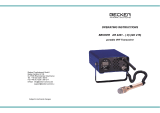
Technical Instruction
General Description
4 AR6201 Retrofit-Instructions Issue 01 November 2016
Table of Contents
1. General Description ....................................................................................................................... 8
1.1. Introduction .................................................................................................................................... 8
1.2. Device Assignment ........................................................................................................................ 8
2. Preparation - Transceiver Replacement ...................................................................................... 9
2.1. Visual Inspection ........................................................................................................................... 9
2.2. Functional Test .............................................................................................................................. 9
3. Replacement of the Transceiver ................................................................................................ 10
3.1. AR4201 → AR6201 ..................................................................................................................... 10
3.1.1. Removal of AR4201 .......................................................................................................... 10
3.2. Pin Compatibility AR4201 - AR6201 ........................................................................................... 11
3.2.1. Dynamic Microphone Input ............................................................................................... 12
3.2.2. Temperature Sensor ......................................................................................................... 12
3.2.3. RS232 Interface ................................................................................................................ 12
3.2.4. AFCU/AGC/AFWB ............................................................................................................ 12
3.2.5. CPIN (if Installed) .............................................................................................................. 12
3.2.6. +13.75 V Switched (AR4201) - PWR_EVAL (AR6201) .................................................... 12
3.3. Verification ................................................................................................................................... 13
4. Post Installation Test ................................................................................................................... 14
4.1.1. Mechanical Installation and Wiring Check ........................................................................ 14
4.1.2. Power Supply .................................................................................................................... 14
4.1.3. Receiver / Transmitter Operation ...................................................................................... 14
4.1.4. Antenna Check .................................................................................................................. 14
4.1.5. Interference Check ............................................................................................................ 15
4.1.6. Flight Test Check .............................................................................................................. 16
4.2. Magnetic Compass Interference Test ......................................................................................... 17
5. Technical Data ............................................................................................................................. 18
6. Index .............................................................................................................................................. 20





















